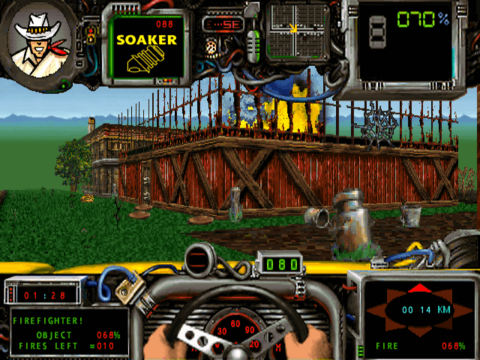
Quarantine II: Road Warrior
Written by: Rik
Date posted: May 17, 2020
- Genre: Action
- Developed by: GameTek
- Published by: GameTek
- Year released: 1995
- Our score: 3
Quarantine was based on a fairly easy to digest concept: hover cab driver Drake Edgewater tries to make a living in a dystopian future prison city, Kemo. Mixing driving and combat, the emphasis on open-world possibilities and getting your fares to their destinations on time soon shifted to a storyline in which you hook up with a rebellion movement and aim to blast your way out of Kemo entirely. (Which – spoiler alert – you do, if you manage to finish the game).
The sequel, in trying to find a reason to exist, complicates that setup somewhat, with the introduction here dismissing the climactic ending of the first game almost immediately, and upon Drake’s triumphant escape from Kemo, the city is revealed to be but a small part of a much larger world, all of which happens to be controlled by Omnicorp, the same evil company from the first game.
While Quarantine was fairly narrative-light, with the CD version providing a handful of cheap FMV sequences to supplement the text-based mission briefings as you picked up passengers, Quarantine II: Road Warrior features regular interludes in the style of a graphic novel, the first of which unveils a collection of named antagonists, including the ultimate big bad, Torva Yul, a green-skinned demon type in a suit. Meanwhile, an overall map of the game world reveals the path to Mr Yul: a series of themed levels similar to those in Kemo City, linked by a number of desert-based sequences, ultimately leading to the final confrontation.
Road Warrior certainly takes the series in an odd direction. When revisiting the first game, I thought several times about the stranger moments in this sequel and wondered if I was perhaps misremembering some of the details. However, it turns out that there is indeed a section set in a backwards, agricultural environment, and a mission in which you are tasked with extinguishing several barn fires by launching condoms full of water at them. And also a mission which requires you to destroy giant vegetables. And one that features cow tipping as an objective.
Broadly speaking, the things that have changed for this sequel often highlight and accentuate the problems with the things that have stayed the same. For example, the graphics haven’t had much of an overhaul, beyond adding a SVGA mode, which does sharpen things up but also does nothing to improve the draw distance. While the fogging effect could arguably have been explained away in the context of Kemo City, out in supposedly wide open spaces, it just seems like the shortcoming it obviously is.
Driving remains a dodgem-style crash-bash affair, as idiotic drones continually collide with you and send you smashing into buildings, upon which you can get stuck. This was pretty annoying in the first game (to the extent that my friend and colleague was forced to excuse himself from our planned discussion piece), but still sort of made sense in a supposedly lawless madhouse, whereas here it just means every supposedly different environment is still filled with the same morons ploughing into you repeatedly as you try and get across the map to deal with your actual mission.
The idea of you as a freelance taxi driver, earning money to maintain your cab and purchase weapons, has been ditched completely, and so Road Warrior is reduced to a basic set of linear missions. As you start each one, your armour will immediately be returned to 100% and you’ll be equipped with all the weaponry you need to complete the next mission. (Ammo will be limited, though, so you will at least need to apply some judgement during proceedings rather than simply holding down the fire button, although the latter does often suffice as a strategy).
Once you’re done, it’s rinse and repeat. You could, in theory, try and explore the levels between missions, and familiarise yourself with the layout (although you can actually consult the map and your location on it at any time) but there’s otherwise nothing else to do, other than provoke random confrontations to no positive effect.
On the plus side, this approach does simplify things somewhat, and ultimately progress in the first game relied upon completion of a series of missions anyway. Progress is fairly straightforward as it’s usually pretty clear what you have to do: most often, find and blow up a building or enemy. They’re pretty easy to blunder through, especially if you keep your eye on the main target and don’t get bogged down in fights with sundry supporting enemies, who can be ignored unless they’re causing significant harm to your chances.
Combat is never against intelligent opposition, with the main challenge often provided by the need to navigate through the map and complete your objective within a time limit. Most of the time your enemies, when you find them, simply float about helplessly while you unleash your weaponry. This is particularly jarring when the briefing states that some bad-ass is trying to kill you, when it actually seems more like they’re running away if anything, and uninterested in any kind of confrontation.
Many missions literally amount to no more than, ‘go here and blow up a building with a missile’. You may well encounter opposition, but as previously indicated, you can just ignore this and focus on the task at hand, completion of which will cause these enemies to disappear. Defeat, when it comes, is usually down to being overwhelmed by a large number of drones firing at random. On this note, it’s worth saying that on the missions that specify a set number of enemies are to be defeated, particularly when those enemies are pedestrians, you can observe many more than that number on-screen, with the mission simply ending when the number ticks down to zero, even if you can see some still remaining. (To be clear, your mission is never ‘just kill 30 of these 50 guys’ – you’re meant to kill all of them, but instead of generating the required number, the game keeps fizzing them out at you). Still, you can save at any point, and nothing keeps you occupied for too long.
There is some attempt at variety, although the occasional escort mission is to be dreaded as the game just isn’t set up for any kind of precision combat, and these are completed more through luck than judgement. Elsewhere, there’s an effort to dress up the same basic tasks in different ways, but it still becomes rather repetitive very quickly, and you have the sense that the game is being bulked out by the sheer number of missions rather than any challenge. There’s a rotating cast of characters who attempt to give you some kind of context for your actions but there’s no real thread linking the missions and building to any kind of notable climax. Missions that sort of seem like boss fights appear in the middle of a particular level, which may be finished with a comparatively low-key one instead.
The story is, frankly, a bit weird. The art, to my untrained eye, actually looks quite good, but the story reads like the kind of thing a teenager might make up on the spot without any pause for reflection. Drake, clearly a reluctant hero, is given increasingly tenuous reasons to proceed to the next level: there’s a lot of stuff about leading a rebellion and setting the people free, but at the same time you mainly seem to be gunning down the inhabitants of each level and blowing up their buildings.
The only other real items of note are the seemingly direct plagiarism of the OCP logo from RoboCop, and the references to Mad Max (beyond using the ‘Road Warrior’ subtitle) felt most obviously in the desert sections, which do at least free you from the collision frenzy of the normal levels and place some emphasis on driving, although, again, the best tactic is to just avoid all enemies other than any mission-critical ones and gun it as fast as you can to the end of the level. Oh, and there’s some noisy CD-quality music, too, which I turned off as it was a bit ‘much’. [Ok, Grandad! – FFG reader]
Completing the game shouldn’t be too difficult, although the conclusion to the story, such as it is, is more baffling than satisfying. Overall, it’s quite a strange experience. The best that can be said is that it’s perhaps less frustrating than its predecessor, but stripped of that game’s novel setup, all that’s left is quite an incoherent and low quality hover-car shooter. Not quite Zone Raiders, then, but not too far off.

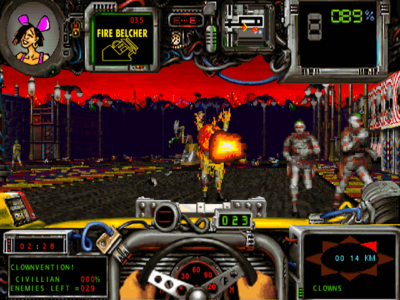
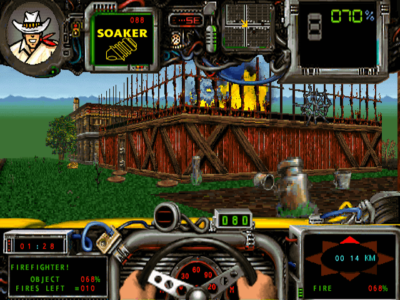
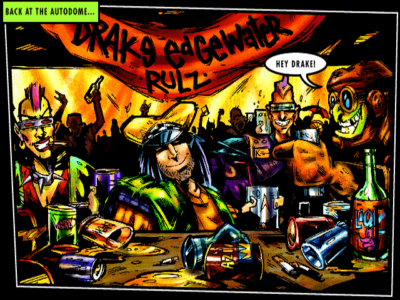
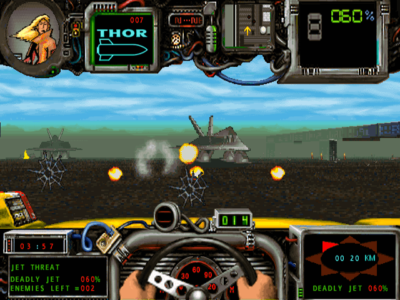

 Posts
Posts